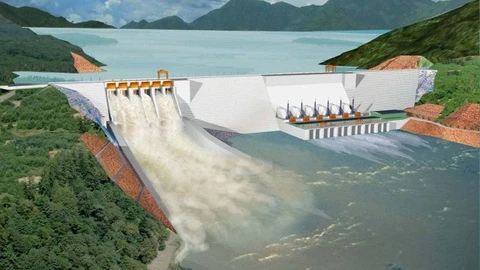
Long history of imbalances
Songda 7 Joint Stock Company is a unit of Song Da Corporation that was established in 1976 at the construction site of Thac Ba Hydroelectric Plant in Yen Bai Province, and was the first hydroelectric plant in Vietnam. Immediately after it was established, SD7 supported the construction of the Hoa Binh Hydroelectric Plant on the Da River with total capacity of 1,920MW.
In the process of rapidly developing further, SD7 became involved in many other major construction projects across the country, such as Bai Bang Paper; Yaly Hydropower of 720MW capacity; Tuyen Quang Hydropower of 342MW capacity; Son La Hydropower of 2,400MW capacity; Nam Chien 1 Power Plant of 220MW capacity; Lai Chau Hydropower of 1,200MW capacity; the Ho Chi Minh Road, and several other industrial and civil projects.
In 1996, SD7 was classified as a Category I enterprise, and in 2005 converted to a Joint Stock Company. This was the most prosperous time for SD7. During this time, it undertook the production and supply of materials for construction sites at Son La Hydropower Plant for a huge quantity of 10 million m3 of sand and crushed raw stone. SD7 imported four crushing and screening lines with capacity of 350,000 m3 per year from Russia, and imported one transmission line with capacity of 650,000 m3 per year from Sweden, along with modern German made mixing plants to coordinate cold water production for the Dam Lan concrete dam works.
Soon after changing its operating model, instead of being a construction contractor, SD7 adopted a haphazard plan to invest in building small and medium hydropower projects for commercial electricity, such as the Yan Tann Sien Hydropower Project of 5MW capacity and the Nam He Hydropower Project of 16MW capacity. In addition, SD7 also invested in real estate businesses, industrial parks and mining.
Irrational decisions
By stepping into unchartered territories with little experience in any, SD7 soon began to face phenomenal losses from 2015. According to the 2015 financial report, the company's profit showed VND 600 million, but consolidation of SD7 subsidiaries business results saw a loss of VND 14.5 billion. Explaining the cause of this loss, SD7 leaders acknowledged the fact that long-term financial investments had not been effective, causing huge waste of resources, and potential devastating risks for future of the business. By the end of 2015, SD7 invested VND 289 billion in subsidiaries, VND 52.4 billion in joint ventures and associates and VND 52 billion in capital contribution to other entities, while the provision for long-term financial investment for the above was only VND 26.3 billion.
It is worth mentioning that SD7 was showing abnormal signs in functioning since 2013, but no one paid any heed and these were brushed aside by the business leaders. According to the 2012 financial report, the after-tax profit of parent company of SD7 suddenly showed negative results at VND 18.7 billion, with the blame being attributed to mainly subsidiaries, joint ventures and associates. For example, Song Da 8 JSC (with 49.38% stake of SD7) lost VND 35.7 billion, and Yen Son Wood Furniture Company (with 98.5% stake) lost VND 6.6 billion.
However, instead of restructuring by divesting from inefficient businesses, SD7 decided to expand investments in new businesses, and continued to pour more capital and manpower to revive these sinking businesses.
"King of broken promises"
Immediately after changing its model to a Joint Stock Company on 25 December 2006, SD7 offered its stocks on HNX. With the current boom in the stock market, SD7 sublimated to a phenomenal price of VND 494,400 per share. However, after reaching its highest value, SD7 soon began its unstoppable plunge without braking and ended the last trading session on HNX at VND 3,000 per share. On 1 June 2018, SD7 listed again on UPCoM with a commitment to help businesses overcome difficulties. However, contrary to expectations, SD7 failed to receive the attention of investors due to extremely low credibility caused by a series of wrong decisions in the past. SD7 was even termed the "King of broken promises", with a history of missing dividend payments despite payments being very low. For example, dividends in 2010 were 8% (VND 800 per share), but in 2014 SD7 only paid back with an excuse saying, “cannot arrange capital".
Thus SD7 continuously and adversely affected the stock price. The SD7 partner, Thanh Do Steel JSC also filed an application at the Son La Provincial Court to accept bankruptcy by SD7 due to its nearly VND 4.32 billion debt. As a consequence, SD7 encountered media back lash related to the scandal of Le Huu Trac Institute of Burns Apartment Project. The reason being that it had the same name as the project investor-‘Urban and Industrial Zone JSC Song Da 7’.




















